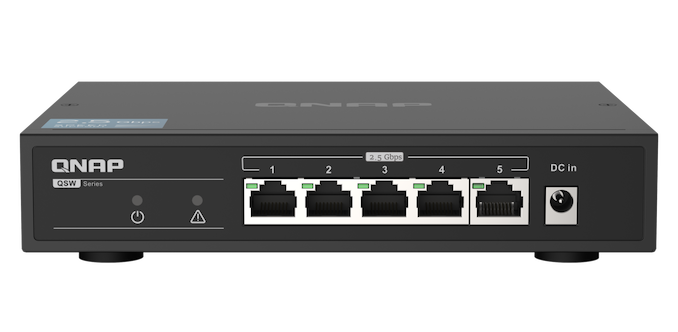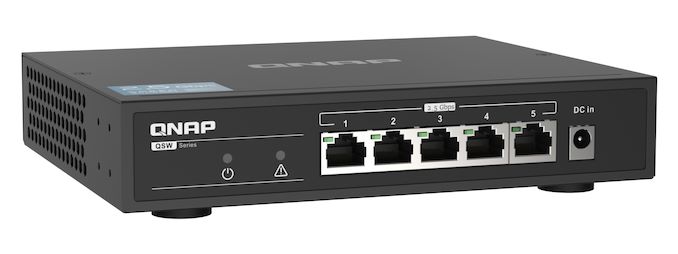At Last, a 2.5Gbps Consumer Network Switch: QNAP Releases QSW-1105-5T 5-Port Switch
by Ryan Smith on July 17, 2020 11:30 AM EST- Posted in
- Networking
- QNAP
- NBASE-T
- 2.5GBase-T
- Ethernet
- 2.5 GbE

After entirely too long of a delay, the wait for faster consumer-grade network switches appears to be coming to an end. This week QNAP launched its QSW-1105-5T switch, one of the industry’s first unmanaged 2.5Gbps (2.5GBASE-T) switches. The 5-port switch supports 2.5GbE operation on all five of its RJ45 Ethernet ports, and along with being unmanaged it is also fanless, allowing the switch to work maintenance-free and installed virtually anywhere. The QSW-1105-5T is already on sale in Taiwan for roughly $100, meaning that we’re looking at a price-per-port of about $20.
The saga of NBASE-T has been something of a long one. First introduced in 2016, the standard added the then-new 2.5GBASE-T and 5GBASE-T modes, which were designed to offer a series of intermediate steps between the existing 1Gbps (1000BASE-T) and 10Gbps (10GBASE-T) standards. By scaling down parts of the 10GBASE-T spec, the new standards would allow more modest – but still many times faster – network transmission rates than 1Gbps Ethernet, all the while being able to reuse existing Cat5e and Cat6 cabling. Overall, 2.5GBASE-T allows for 2.5Gbps Ethernet over Cat5e at the same 100m distances as 1Gbps Ethernet, while 5GBASE-T allows for 5Gbps speeds over 100m runs of Cat6, as well as quasi-official support for shorter Cat5e runs.
Given the technology reuse, moderately-priced NBASE-T network cards were quick to hit the market. However affordable switches have been a more complex matter: while the high initial price of NBASE-T was easy enough to eat on a single controller, multiplied over several ports on a switch, it quickly drove up the price tag. As a result, the market for NBASE-T switches has largely between split between downgraded pro gear like Netgear’s $70-per-port XS505M, and mixed-port switches like Asus’s XG-U2008, which offer just two 10G/NBASE-T ports along with a slew of Gigabit Ethernet ports. So cheap NBASE-T networking options have remained elusive, at least until now.
Thankfully, in the last year we’ve finally started seeing the slower of the NBASE-T modes, 2.5GBASE-T, sprint towards wide adoption. The 2.5Gbps standard is the cheapest to implement, and with recent controller releases from the likes of RealTek and Intel, 2.5Gbps controllers have quickly become a staple on high-end motherboards. Accordingly, with the price per port coming down for 2.5Gbps controllers, it’s also bringing down the price of whole switches. And this is where QNAP’s new switch comes in.
The QSW-1105-5T is one of the first switches to be released using these new generations of cheap controllers. Aimed squarely at the home and SMB markets, the switch doesn’t offer any frills such as network management, Power over Ethernet, or SFP+ ports. Instead it focuses on the things that matter for the home market: supporting 2.5Gbps networking in a small, passively-cooled switch that’s suitable to be neglected by being tucked under a desk or in a closet.
| QNAP QSW-1105-5T Switch | |
| Speeds | 100M/1G/2.5G |
| Ports (RJ45) | 5 |
| Managed | No |
| Power | 12 W |
| Dimensions | 3.4 x 18 x 14.5 cm |
| Cooling | Passive (Fanless) |
| Price | ~$100 |
As the first of what will undoubtedly be many 2.5G switches over the coming months, the QSW-1105-5T also gives us our first real look at what we can expect from this generation of switches as far as footprints and power consumption goes. Since it’s not carved from a pro-grade switch, the 18 cm x 14.5 cm switch is significantly smaller than earlier NBASE-T switches. And with a maximum power consumption rating of 12 W, we’re looking at power consumption of just a bit over 2 Watts per port, which is also a significant improvement over admittedly far more powerful switches.
All of which sounds unremarkable, and indeed that’s exactly what makes the QSW-1105-5T so interesting. The biggest barrier to wide consumer adoption over the last few years has been the cost – both in regards to the core technology and added frills – so we’ve been waiting for quite a while to see NBASE-T technology transition from pro-grade switches to cheap, consumer-grade gear.
Otherwise, QNAP’s new switch is further evidence that the PC industry is going to coalesce around 2.5Gbps Ethernet for the time being. Besides being the fastest standard to officially and fully support Cat5e cabling – which was installed in walls en masse when home networking first took off – it’s also the cheapest and lowest-power option. This is allowing it to be widely deployed not only in new motherboards and cheap USB adapters, but finally in switches as well – and making QNAP’s new switch a good match for all of those new NICs. And while I’d like to see cheaper 5Gbps and 10Gbps gear as well, 5GBASE-T seems likely to remain a premium (if not niche) option, owing to the higher controller costs as well as its higher power consumption, both of which remain big problems for a switch.
At any rate, QNAP’s 2.5Gbps switch is on sale now in Taiwan. The company has not announced release dates elsewhere, but judging from some of their previous product releases, I’d expect it to start showing up in North America some time in the next few months.
Source: QNAP

















98 Comments
View All Comments
Gigaplex - Saturday, July 18, 2020 - link
I live in a city with 5 million people (Melbourne, Australia). I still can't get ANY form of fixed line internet. I'm running off 4G. My neighbours, literally 5 metres away, have NBN.pinchies - Saturday, July 18, 2020 - link
Knock on the door, ask them nicely to offer to split costs of their internet bill.... I'd be surprised if they said no! NBN100 ain't cheap!Notmyusualid - Sunday, July 19, 2020 - link
I hope you are friendly with that neighbour. I'd be tapping him up for a box of my own, or at least a tap of his existing network. All for a big favour, no doubt.My brother nearly bought a house three doors down and behind mine. I knew instantly I'd be dumping my connection, and installing a point-to-point radio link to tap his.... but he didn't buy in the end.
twtech - Friday, July 17, 2020 - link
Normal people "didn't" have those things, but that's because most normal people didn't work from home. That's changing now though for many.nagi603 - Saturday, July 18, 2020 - link
Yep, one of the most common fixes for shitty meeting video is having a damned wired connection, especially in apartment building complexes.close - Saturday, July 18, 2020 - link
@twtech: Having cheap 10G everywhere would be great. But nobody in the history of WFH (hooray hyperbola!) was ever limited by the 1G LAN connection, That's because even in the office your laptop is pretty much guaranteed to be connected to a 1G LAN (seeing how almost no laptop has anything better). So you're limited by your internet connection. Having 10G or 100G in your LAN will make 0 difference to how fast your Zoom meeting works.Unless your job is to have a 10G connection at home...
The reason we don't have 10G is that people don't even understand what it's for (e.g. you). Putting a hefty price tag on something they already don't understand makes it a hard sell for regular people, even those who just buy shiny numbers they don't understand because someone said it will make their WFH faster. People who *need* 10G have it already.
rahvin - Sunday, July 19, 2020 - link
The same things were said of the earliest network standards to 10Base-2 to 10BaseT on up through to 1G network.Standards evolve, data transfer increases. In time 10G will the home standard if wired isn't totally displaced by Wifi 6 as the last connection in the network segment as some are predicting it will do.
TheinsanegamerN - Monday, July 20, 2020 - link
You keep missing the point, the bottleneck is the internet connection to the house. You can easily stream 4k over a 1G connection, and the honest truth is that despire 2 decades of evolution consumers still dont have a need for faster then 1G speeds 99% of the time. That's why 10G penetration has been so limited.We have a LONG way to go before even 2.5G internet is widely available, let alone 10G, and until then there will be no demand from home users for these faster speeds.
Holliday75 - Monday, July 20, 2020 - link
My switches at work have 10gbps trunks and its rare to see them jump above 10% utilization in a building with 500 people who are all using copper and/or WiFi along with our automated services and camera system.If anything we're getting more efficient data usage per device. The only reason our data usage is going up is we are adding more gear to use it the bandwidth. I am trying to fathom what the average person at home would be doing to need something that wide. Maybe some day we'll have audio/video sensors all around the home that stream data to an AI service. As it stands now I cannot use even a small percentage of that bandwidth even if I tried.
Gigaplex - Monday, July 20, 2020 - link
"You keep missing the point, the bottleneck is the internet connection to the house."No, you keep missing the point. There are things that happen on home networks that don't require the internet.